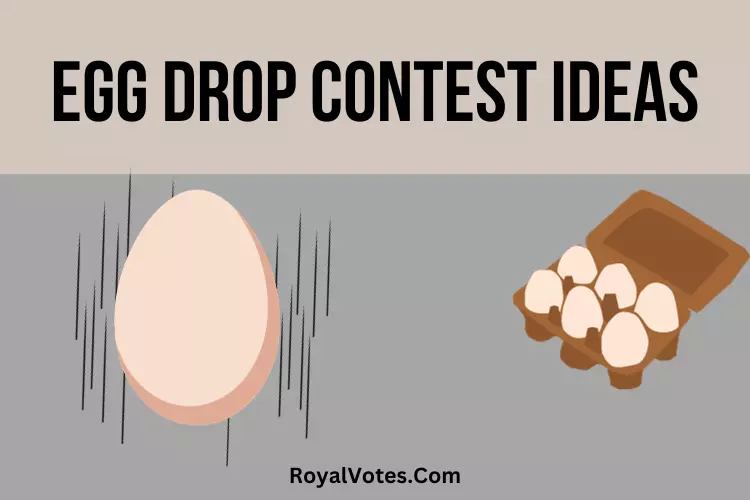Want some awesome egg drop contest ideas for your next school science fair? Okay, I got you. Here are the best 15 egg drop project ideas for the contest that will spark students’ creativity.

Egg Drop Contest: What Is It?
The egg drop contest is a super fun activity for students. They get to build a gadget that can keep an egg safe when dropped from a certain height. It’s all about Newton’s laws of motion and potential and kinetic energy.
This fun and engaging activity encourages critical thinking and problem-solving skills and promotes teamwork and collaboration. And let’s remember the excitement and friendly competition that comes with it!
15 Best Egg Drop Contest Ideas for School
Now, let’s get into the ideas for the egg drop contest. These ideas are perfect for students of all ages and can be easily adapted to fit different skill levels. So gather your materials, and let’s get cracking!
#1. The Classic Parachute
The Classic Parachute is a timeless choice. Students can design a parachute that slows the egg’s descent, reducing the impact on landing. It’s a great way to demonstrate air resistance and its effects.
Encourage them to experiment with different materials for the parachute and the strings. This hands-on activity is perfect for understanding basic aerodynamics.
#2. DIY Straw Structure
Want egg drop project ideas with straws? The DIY Straw Structure challenge is about building a protective frame using straws and band or tape. The aim is to create a structure that’s both lightweight and sturdy enough to cushion the egg. You can get creative and try different designs like a cube or pyramid shape.
It’s a cool activity that lets students explore the strength and stability of simple shapes. Plus, it’s a fantastic way to teach structural engineering principles and show how weight distribution matters!
For more practical learning, check out the below video content.
#3. Balloon Basket
With the Balloon Basket idea, students can use balloons to create a cushioning effect. They can make a basket around the egg and let the balloons absorb the shock when it drops. The important thing is to make sure the egg stays safe even if the basket breaks on impact. This concept is awesome for exploring air compression and tension forces.
#4. Popsicle Stick Fortress
The Popsicle Stick Fortress is all about using popsicle sticks to build a protective cage. Students can get creative with their designs, learning about geometric shapes and their strengths. It’s a hands-on lesson in how shapes and materials can provide stability and protection. Also, it’s an activity that teaches the importance of planning and precision.
#5. Sponge Safety
Sponge Safety involves using sponges to create a shock-absorbent layer around the egg. Students can experiment with different sponge types and arrangements to see which provides the best cushioning.
It is excellent for understanding how different materials absorb impact. Plus, it’s a mess-free idea that can be easily done in the classroom.
#6. The Egg Capsule
With The Egg Capsule, students get to design a cool capsule-like structure to protect their eggs. They can use stuff like cardboard, foam, or even recycled items. This awesome idea promotes creativity and resourcefulness, showing how everyday materials can be repurposed for science experiments.
#7. Marshmallow Cocoon
Marshmallow Cocoon invites students to use marshmallows to cushion the egg. This sweet approach to the egg drop challenge is fun and a great way to understand how soft materials can protect against absorption and dispersion of force.
#8. Rubber Band Basket
In the Rubber Band Basket idea, students create a basket with rubber bands acting as shock absorbers. This project is perfect for illustrating the concept of elasticity and how it can be used to reduce impact forces.
#9. Cotton Cloud
Cotton Cloud requires students to use cotton balls to create a fluffy, cloud-like cushion for the egg. It’s a simple yet effective way to teach about the properties of materials and how they can be used to prevent damage from impacts.
#10. Water Cushion
With Water Cushion, students use the principle of fluid dynamics. They create a container where the egg can be surrounded by water, which helps to distribute and absorb the shock of the drop. It’s a unique approach that introduces the concept of non-Newtonian fluids.
#11. LEGO Lockdown
LEGO Lockdown challenges students to use LEGO bricks to construct a protective enclosure for the egg. This idea is great for fostering creativity and understanding how interlocking structures can add strength and stability.
#12. Newspaper Nest
In Newspaper Nest, students use layers of newspaper to create a cushioning effect. They can roll, fold, or crumple the newspaper to find the most effective technique. This method teaches about the properties of paper and how it can be manipulated to absorb shock.
#13. Foam Fortress
Foam Fortress encourages students to use foam sheets or foam blocks to protect the egg. This idea is perfect for exploring how different thicknesses and densities of foam can affect impact resistance.
#14. Boxed In
Boxed In involves creating a protective enclosure using small boxes or cartons. Students can fill these boxes with various materials to find the best cushioning solution. It’s a great exercise in understanding how confinement and padding work together to protect an object.
#15. Bubble Wrap Bounce
Bubble Wrap Bounce is all about using the classic packing material, bubble wrap, to safeguard the egg. Students can wrap the egg with multiple layers and experiment with different bubble sizes to see which provides the best protection. This idea perfectly explains how air pockets can act as shock absorbers.
Read also: Drawing contest ideas
How to Do an Egg Drop Competition at School?
Running an egg drop competition at school can be a fun and engaging activity for students of all ages. Here are some steps to help you organize and run a successful egg drop competition:
Choose the date and location:
Decide on a date and time that works best for your school schedule. Depending on the weather and available space, you can also choose to hold the event in an indoor or outdoor location.
However, this contest is celebrated on National Engineering Week in most countries. You may find another date related to science, education, physics, engineering, etc.
Set the egg drop challenge rules:
Establish clear guidelines for the competition and communicate them to all participants. This includes specifying the materials that can be used, size limitations, and any other requirements.
Egg drop contest rules example:
- The egg must be raw and uncooked.
- The container must have a maximum size of 20cm x 20cm x 20cm.
- Only approved materials (e.g., cardboard, foam, rubber bands) can be used.
- The egg must be visible at all times during the drop.
- The egg must remain intact and unbroken to count as a successful drop.
- Each participant gets three chances to drop their egg from increasing heights.
Gather supplies:
Make sure to gather all the necessary materials for the competition. This includes containers for the eggs, protective materials, and any other items needed for construction.
You can also ask students to bring in their own supplies or provide a list of recommended materials for them to use.
Promote and advertise the event:
Spread the word about the competition by creating posters, flyers, or announcements. You can also involve different departments or classes to help promote the event. Also, consider involving local businesses or organizations to sponsor the event and provide prizes for the winners.
Host a design workshop:
Before the contest, consider hosting a design workshop where students can learn about different engineering concepts and brainstorm ideas for their egg drop containers. This can also be an opportunity to provide tips and strategies for constructing a successful container.
Read also: Design contest online
Run the competition:
On the day of the competition, have designated drop zones marked at different heights for the egg drops. Allow each participant three chances to drop their egg and record the results. You can also have judges present to evaluate the designs and determine winners.
Encourage creativity:
Encourage students to think outside the box and come up with unique designs and ideas. This will make the competition more exciting and allow for diverse solutions.
Award prizes:
After all participants have completed their drops, award prizes for different categories such as Most Creative Design, Strongest Container, or Longest Drop Survived. This will encourage students to think out of the box.
How to Select the Winner of the Egg Drop Contest?
Selecting the winner of the egg drop contest winner can be challenging, especially with so many creative and innovative designs. Here are some tips to help you choose the best design:
- Consider the rules: Make sure the winning design follows all the rules and guidelines for the competition. Disqualify any entries that do not meet the requirements.
- Evaluate creativity: Look for unique and out-of-the-box ideas in the designs. Award extra points for creativity and originality.
- Test durability: Drop each design from a set height multiple times to see how well it holds up. Designs that successfully protect the egg from damage should be given higher scores.
- Consider aesthetics: While functionality is important, also consider the appearance of each design. A visually appealing and well-crafted design can also be a significant factor in choosing the winner.
- Involve judges: Have a panel of judges with different areas of expertise evaluate each design. This can provide a well-rounded assessment and help in selecting the most deserving winner.
- Follow a point system: Create a points system that assigns scores based on certain criteria, such as creativity, functionality, durability, and aesthetics. This can serve as a fair and objective way to select the winner.
- Involve audience participation: Consider having an audience vote for their favorite design. This can add an element of fun and excitement to the competition. However, make sure that this does not overshadow the decisions made by judges.
10 Best Prize Ideas for Egg Drop Contest Winner
What should you give the winner of the egg drop contest? Here are ten ideas for prizes that you can award to the winner of your egg drop competition:
- Science kits: Encourage students’ interest in science by gifting them a fun and educational science kit as a prize. What to include in the kit? This can vary based on the age and interests of the winner, but some options include a chemistry or physics set, a DIY solar-powered robot kit, or a crystal growing kit.
- STEM books: Foster their love for learning with engaging STEM books. You can choose from a variety of topics, such as engineering, physics, coding, or space exploration.
- Customized trophy: Recognize the winner with a personalized trophy. You can engrave it with their name, the date of the competition, and any other relevant information.
- Gift cards: Give them the freedom to choose their own prize by giving them a gift card to a store or website that sells STEM-related products or educational materials.
- Robotics kit: Challenge their problem-solving skills with a robotics kit. These kits allow students to build and program their own robots, providing a fun and enriching learning experience.
- Virtual reality headset: Take them on a virtual journey with a VR headset. This can open up new worlds of exploration and discovery for the winner.
- Telescope or microscope: Encourage their curiosity about the world around them by gifting them a telescope or microscope. These tools can help them discover and learn about the wonders of science.
- 3D printer: For older students, a 3D printer can be an exciting prize that allows them to bring their designs to life. This technology can inspire creativity and innovation in the winner.
- Subscription box: Gift a subscription to a STEM-themed monthly box. These boxes contain hands-on activities, experiments, and educational materials that can keep the winner engaged in STEM even after the competition.
- Trophy case: If your competition is an annual event, consider creating a trophy case to display the names of past winners. This can motivate future participants and create a sense of legacy for the competition.
Read also: Halloween costume contest prize ideas
FAQs on Egg Drop Contest Ideas
Can I run an egg drop contest online?
Yes, you can run an egg drop contest via video conferencing platforms and have participants send videos of their drops. You can also conduct the competition through a project-based learning approach where students submit photos and descriptions of their designs.
How can I make my egg drop contest more challenging?
You can make your egg drop contest more challenging by setting strict height limits for the drops, limiting the materials that can be used, or adding additional criteria, such as weight restrictions for the containers.
Can I involve younger students in an egg drop contest?
Yes, you can involve younger students by setting age-appropriate rules and guidelines for the competition. You can also have older students mentor and assist younger ones in designing and building their containers. Lastly, consider having a separate category for younger students to compete in.
Can I combine the egg drop contest with other STEM activities?
Absolutely! You can incorporate the egg drop competition into a larger STEM project or unit of study. For example, you can have students research and design their containers using principles of physics or engineering or have them present their designs and outcomes as part of a science fair.
What is the best material to use for an egg drop container?
There is no one “best” material to use for an egg drop container, as it largely depends on the design and construction of the container. However, some common materials used include foam, cardboard, bubble wrap, and straws. Encourage participants to think outside the box and use unconventional materials in their designs.
Who created the egg drop challenge?
The Egg Drop Challenge was created when teacher Steve Revington stumbled upon a PBS documentary in 1984. The documentary showcased a fascinating activity where an egg was dropped in a specially designed capsule.
Intrigued, Steve introduced the challenge to his grade eight science students, urging them to take on the task themselves. Thus, the Egg Drop Project was born!
Conclusion
I hope you’ve grasped all the egg drop contest ideas well. You can try out various materials and techniques for the egg drop challenge. Whether you’re a student, teacher, or just love science, these ideas will surely make for a fun and educational experience.
And hey, remember to enjoy yourself while learning, and don’t hesitate to get creative with your designs!


